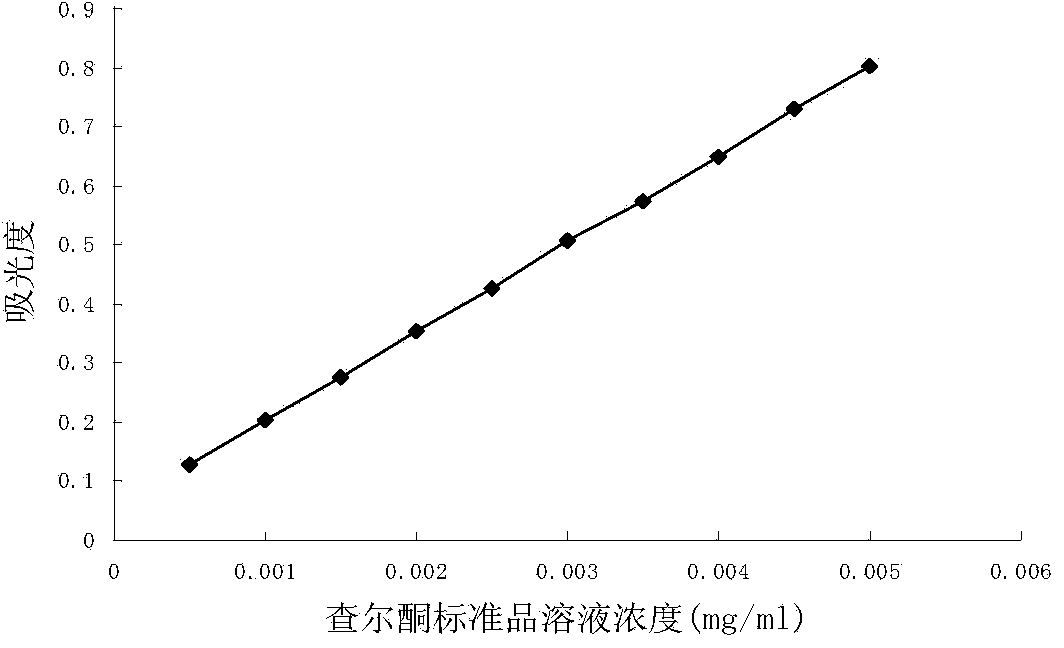Method for rapidly extracting chalcone from fresh ashitaba
A chalcone and fresh technology, applied in the field of separation and purification of natural products, can solve the problems of eutrophication of phosphorus-containing wastewater, a large amount of organic solvents, and large safety hazards, so as to improve the extraction rate, avoid eutrophication pollution, The effect of increasing the extraction rate
- Summary
- Abstract
- Description
- Claims
- Application Information
AI Technical Summary
Problems solved by technology
Method used
Image
Examples
Embodiment 1
[0042] The present invention, a kind of method for rapidly extracting chalcone from fresh and bright Japanese leaves, comprises the following steps:
[0043] Step 1: prepare compound enzyme, weigh and prepare according to the mass ratio of cellulase, dextranase and phytase as 8:2:1, and set aside;
[0044] Step 2: Weigh 1kg of fresh sun leaves, first cut and pulverize, then add 3 times the volume of water to homogenate; pour the homogenate into the extraction tank;
[0045] Step 3: Add 1 g of the compound enzyme prepared in Step 1 to the extraction tank, and stir evenly; adjust the pH to 5.0, and perform enzymatic hydrolysis at 35°C for 40 minutes; filter, and collect the filtrate as Filtrate 1;
[0046] Step 4: Add tetrachloroaluminate (1-ethyl-3-methyl) imidazole solution to filtrate one, the volume of tetrachloroaluminate (1-ethyl-3-methyl) imidazole solution and filtrate one The ratio is 2.5:1, extract at room temperature for 1 hour, filter and collect the filtrate to obt...
Embodiment 2
[0050] The present invention, a kind of method for rapidly extracting chalcone from fresh and bright Japanese leaves, comprises the following steps:
[0051] Step 1: prepare the compound enzyme, weigh and prepare according to the mass ratio of cellulase, dextranase and phytase of 7:3:2, and set aside;
[0052] Step 2: Weigh 1kg of fresh sun leaves, first cut and pulverize, then add 3 times the volume of water to homogenate; pour the homogenate into the extraction tank;
[0053] Step 3: Add 50 g of the compound enzyme prepared in Step 1 to the extraction tank, and stir evenly; adjust the pH to 6.0, and perform enzymatic hydrolysis at 40°C for 60 minutes; filter, and collect the filtrate as Filtrate 1;
[0054] Step 4: Add tetrachloroaluminate (1-ethyl-3-methyl) imidazole solution to filtrate one, the volume of tetrachloroaluminate (1-ethyl-3-methyl) imidazole solution and filtrate one The ratio is 3.5:1, extract at room temperature for 2 hours, filter and collect the filtrate ...
Embodiment 3
[0058] The present invention, a kind of method for rapidly extracting chalcone from fresh and bright Japanese leaves, comprises the following steps:
[0059] Step 1: prepare the compound enzyme, weigh and prepare according to the mass ratio of cellulase, glucanase and phytase of 5:5:1.5, and set aside;
[0060] Step 2: Weigh 1 kg of fresh sun leaves, first cut and pulverize, then add 5 times the volume of water to homogenate; pour the homogenate into the extraction tank;
[0061] Step 3: Add 20 g of the compound enzyme prepared in Step 1 to the extraction tank, and stir evenly; adjust the pH to 6.0, and perform enzymatic hydrolysis at 38°C for 50 minutes; filter, and collect the filtrate as Filtrate 1;
[0062] Step 4: Add tetrachloroaluminate (1-ethyl-3-methyl) imidazole solution to filtrate one, the volume of tetrachloroaluminate (1-ethyl-3-methyl) imidazole solution and filtrate one The ratio is 3:1, extract at room temperature for 1.5h, filter and collect the filtrate to ...
PUM
 Login to View More
Login to View More Abstract
Description
Claims
Application Information
 Login to View More
Login to View More - R&D
- Intellectual Property
- Life Sciences
- Materials
- Tech Scout
- Unparalleled Data Quality
- Higher Quality Content
- 60% Fewer Hallucinations
Browse by: Latest US Patents, China's latest patents, Technical Efficacy Thesaurus, Application Domain, Technology Topic, Popular Technical Reports.
© 2025 PatSnap. All rights reserved.Legal|Privacy policy|Modern Slavery Act Transparency Statement|Sitemap|About US| Contact US: help@patsnap.com



